I grew loads of peppers in my garden this year just so I could make this fermented hot sauce recipe. It is wonderfully spicy and big on flavor. Drizzle it over anything. Works for any type of peppers.
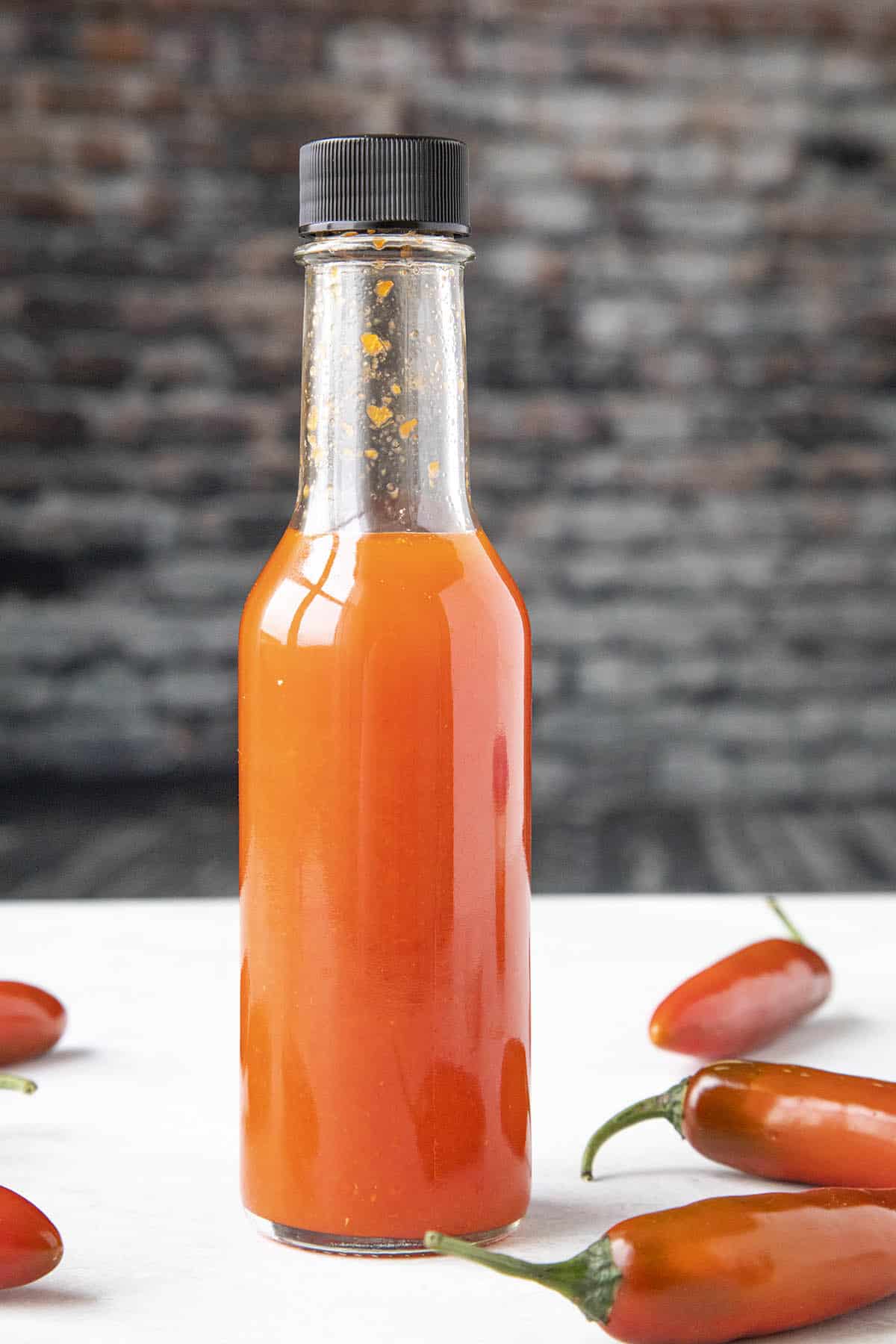
Fermented Hot Sauce Recipe
It's hot sauce making time in the Chili Pepper Madness household again, my friends. You know how much I LOVE my hot sauce. My garden exploded with peppers this year and I'm incredibly happy.
The plants were super productive and I am preserving them in so many different ways.
Food preservation is important. One of my favorite ways to preserve my peppers is to make hot sauce. I have a LOT of different hot sauce recipes here on the site, all with different styles, ingredients, and types of chili peppers.
For this particular hot sauce, I wanted a fermented version, which adds another layer of complexity to the sauce.
I grew serrano peppers and waited for them to turn red specifically so I could make this sauce. So many serranos! The plant was very productive.
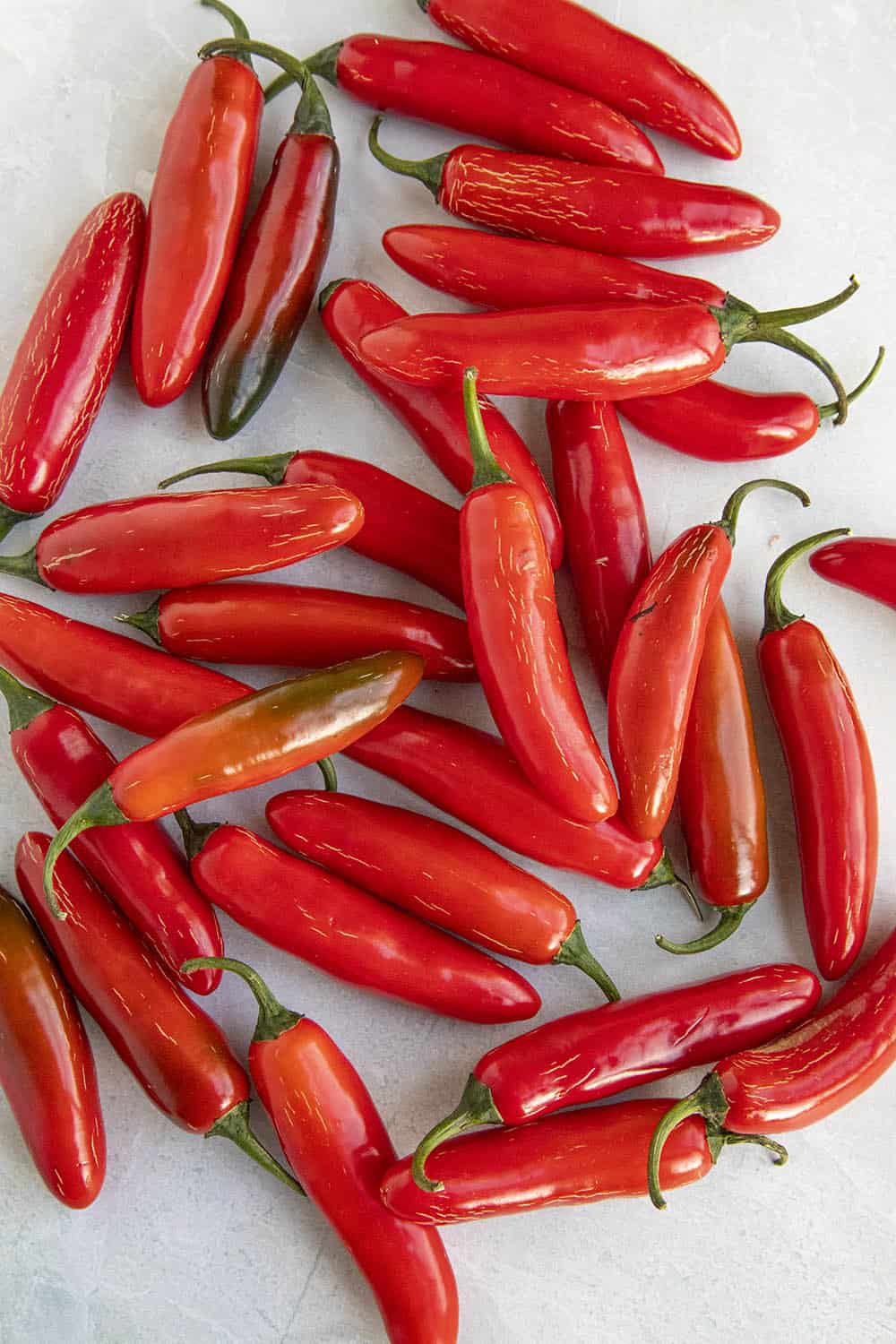
I just love serrano peppers. They're smaller than jalapeno peppers, but quite a bit hotter. In fact, the hottest serrano pepper is about 3 times hotter than the hottest jalapeno pepper.
They measure in at 10,000 to 23,000 Scoville Heat Units on the Scoville Scale. For me, that's a nice level of heat for an every day hot sauce.
You don't have to use serranos, though. This recipe works with any type of chili pepper.
This is a very simple hot sauce recipe, though we're fermenting the peppers first, which may sound complicated, but not at all.
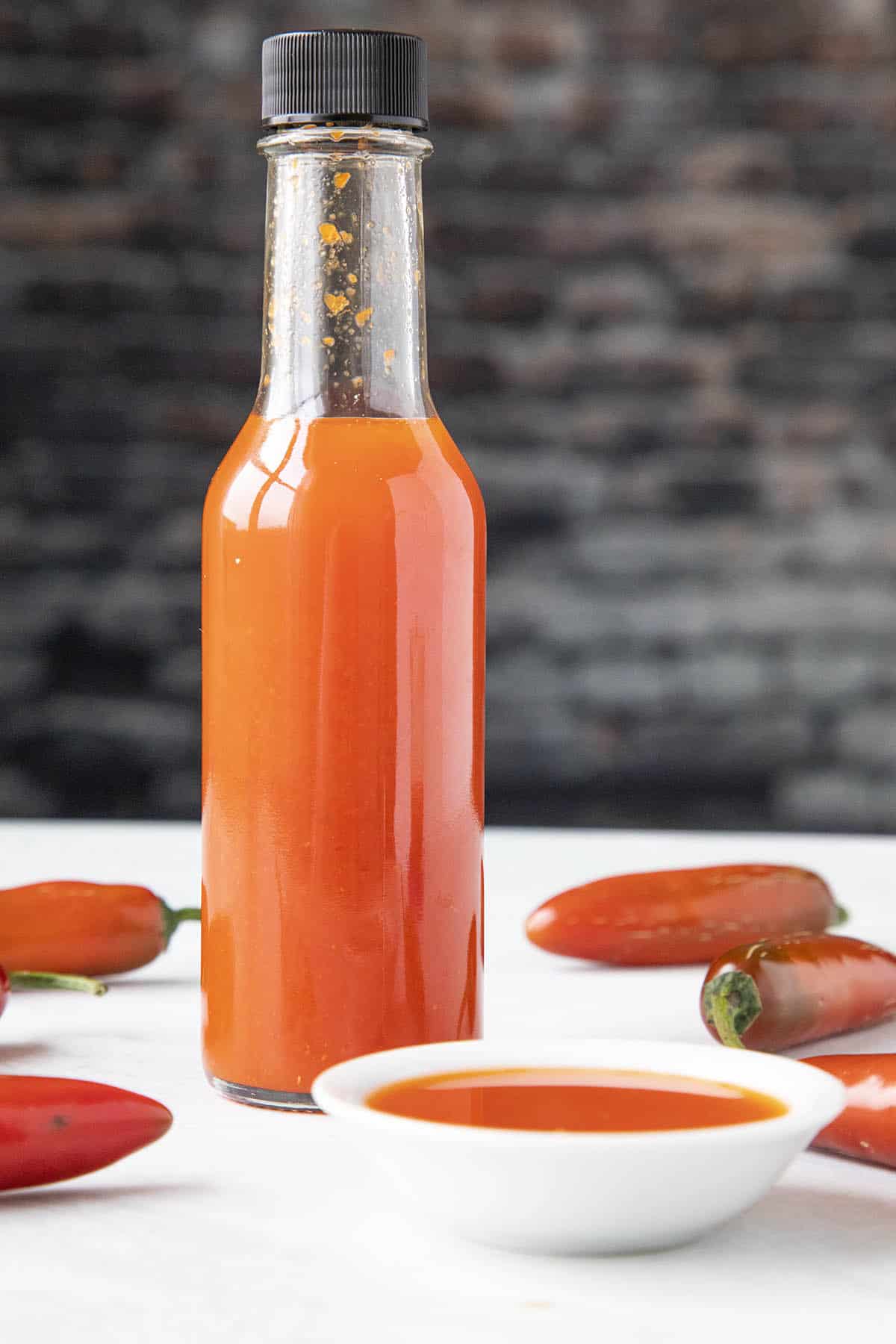
What is Fermentation? And Why is it Good For Hot Sauce?
Fermentation is the decomposition of foods by micro-organisms (Lactic Acid Bacteria) or enzymes. We create an anaerobic (no oxygen) environment for the peppers so that good, beneficial bacteria can survive, and bad bacteria cannot survive.
The good bacteria is natural Lactic acid bacteria, which consumes carbohydrates in the peppers and converts them to acid. After fermenting, the carbohydrates have been predigested, leaving them with more vitamins and flavor than fresh peppers.
Bad bacteria, such as rotting molds, cannot survive in this oxygen-free environment. We create such an environment with salt and brine, which protect the peppers while the good bacteria do their work.
The salt is not actually the preservative. It is the acid produced by the fermentation process that does the preserving.
There are many benefits to fermented foods, including foods that are more digestible and have more developed flavor. When fermenting peppers, the flavors mellow, and peppers change color a bit, and develop a pleasant smell.
Fermentation is one our oldest methods of food preservation. People have preserved foods this way for generations, from wine to cheese to many, many vegetables, including peppers.
Let's talk about how to make a simple fermented hot sauce, shall we? Here is my recipe for fermented hot sauce.
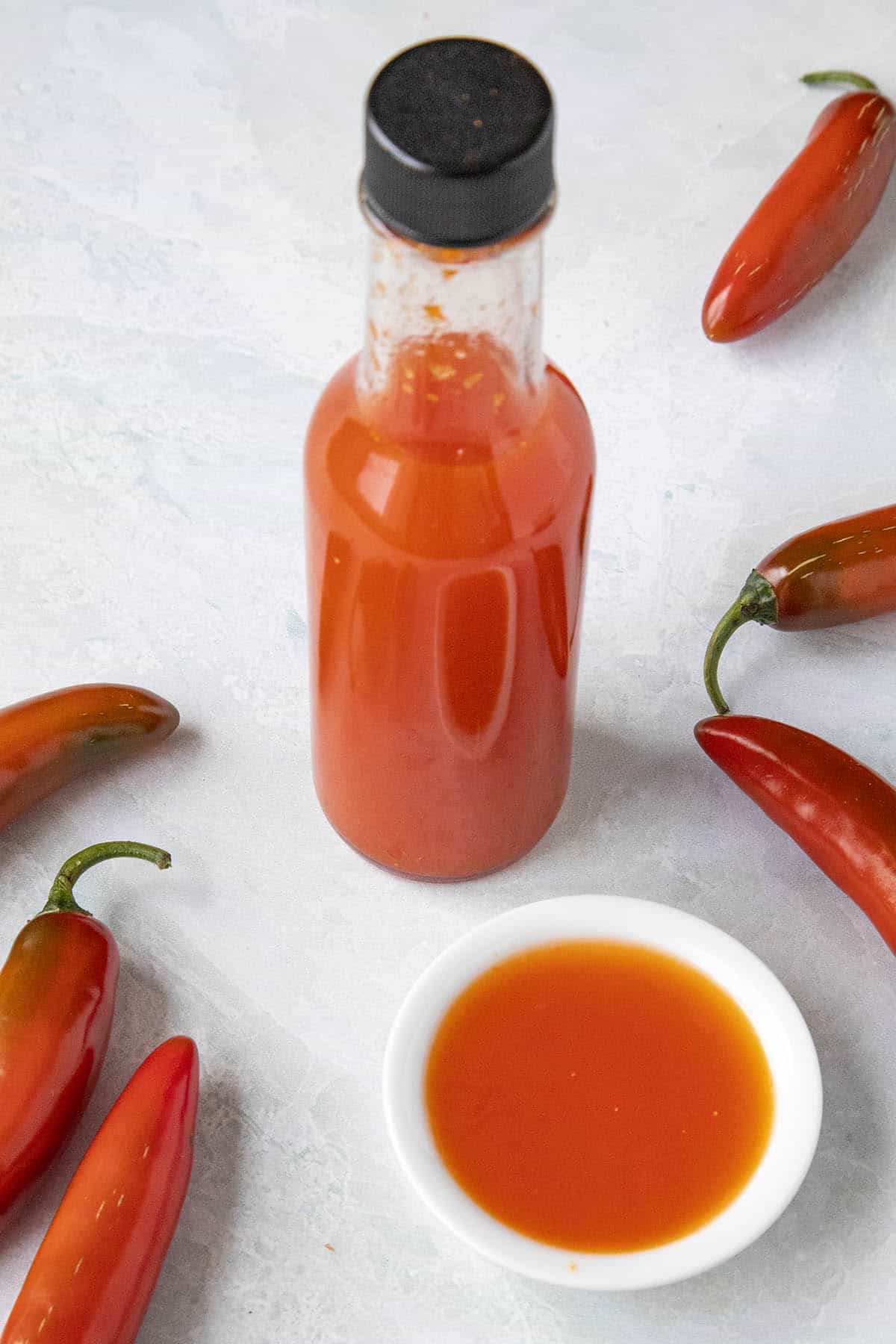
Ingredients Needed to Make Fermented Hot Sauce
- 1 pound chili peppers (stems removed - I'm using red serrano peppers)
- 1 quart unchlorinated water
- 3 tablespoons salt
- ½-1 cup white wine vinegar to your preference (use a good quality vinegar for better quality hot sauce)
How to Make Fermented Hot Sauce - the Recipe Method
First, ferment the chili peppers. Roughly chop the peppers, then pack them into a ball jar, leaving at least 1 inch of head space. The peppers may rise a bit when fermenting.
Mason jars are good to use as fermentation vessels as well.
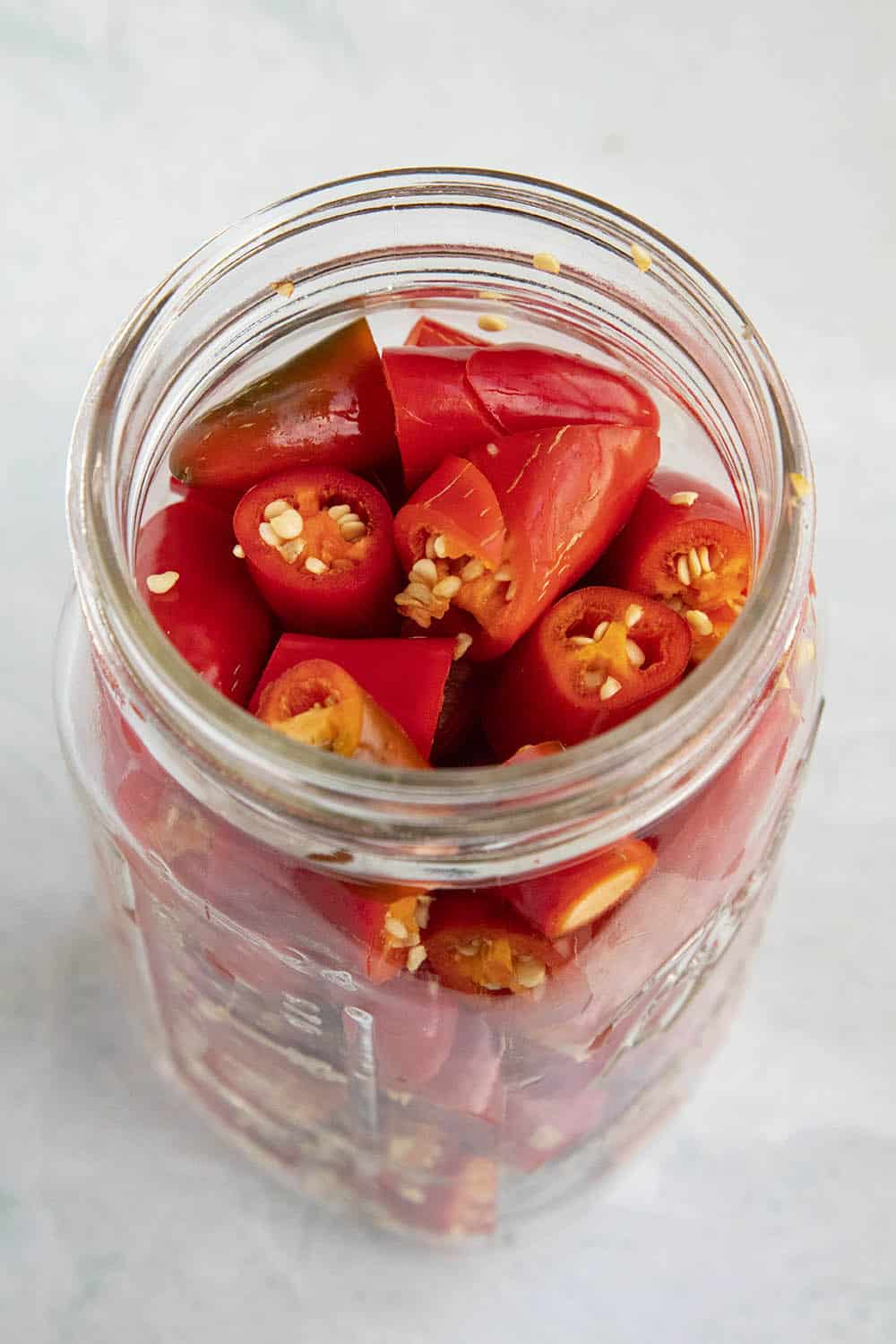
Make the Brine. Next, mix 1 quart unchlorinated water with 3 tablespoons sea salt. Pour just enough brine over the peppers to cover them, pressing them down a bit as you go.
It is important to keep the peppers covered with the salt water brine to avoid spoilage. Check this daily.
HELPFUL TIP: A good method to keep the peppers submerged is to fill a baggie with some water, but not all the way. Stuff the baggie into the top of the jar, forcing the peppers down below the brine.
Screw on the lid and set the jar away from direct sunlight to ferment for at least 1 week. Ideal temperatures are between 55-75 degrees F.
The most active fermentation period is between 1-2 weeks, so be sure to monitor it during this time. “Burp” the jars often by unscrewing the lid a bit to let out some of the accumulating gases.
Or, use an airlock or membrane for easier fermenting. See our page, “How to Ferment Peppers”, for more detailed instruction.
After 1-2 weeks, the fermenting activity will diminish and the brine will turn cloudy and taste acidic, with a slightly sour flavor.
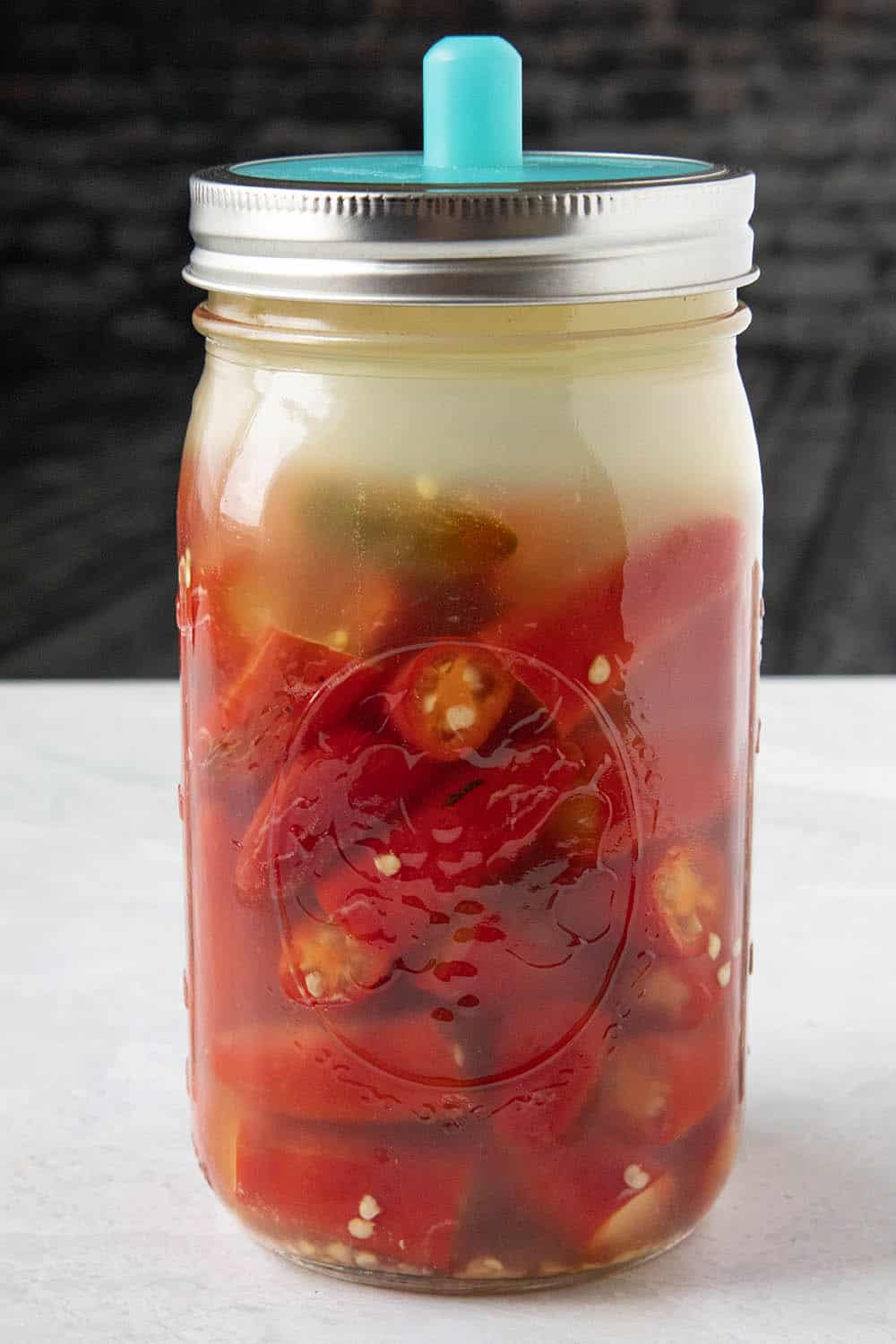
Drain the peppers, but reserve the brine.
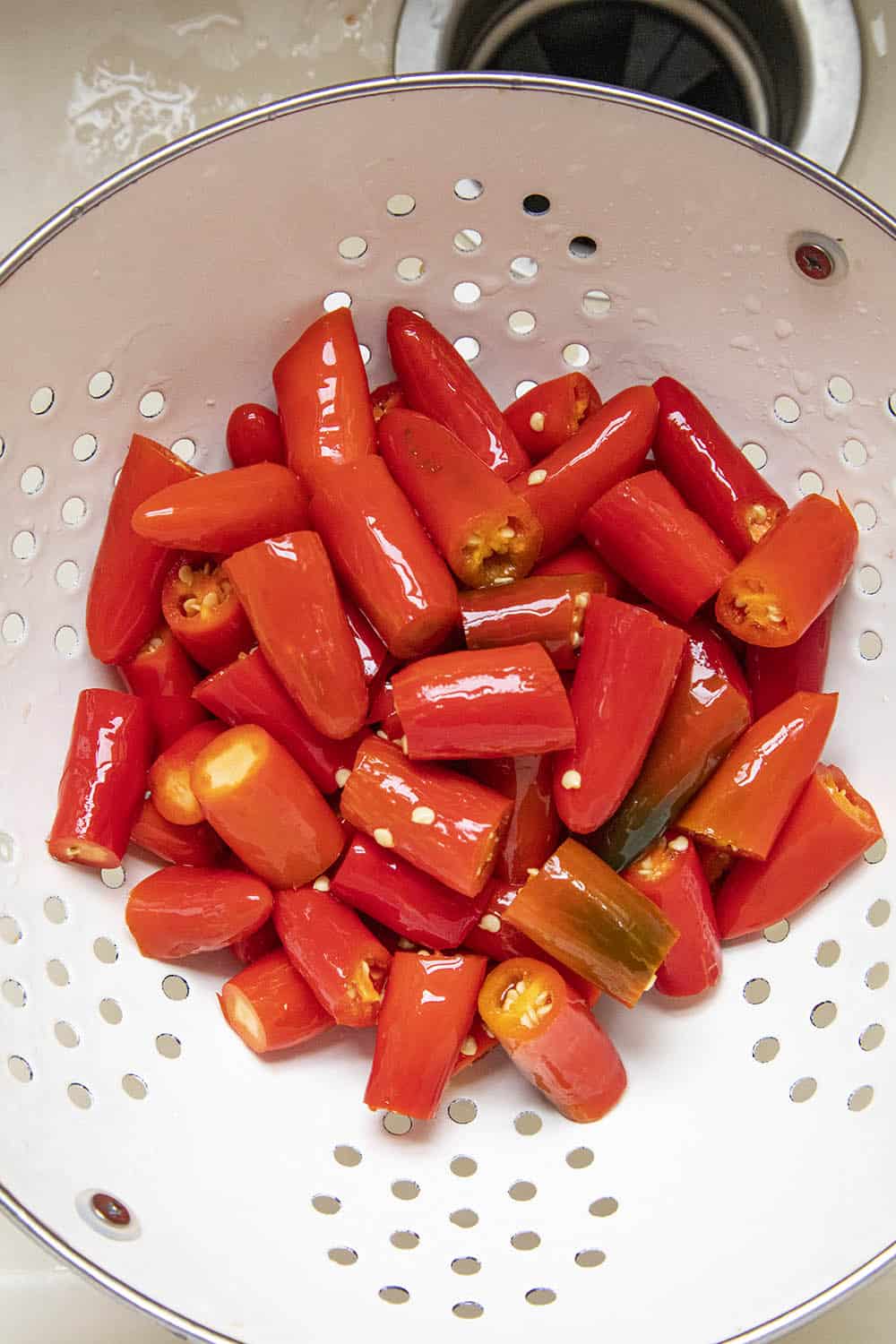
Add the fermented peppers to a food processor or blender, along with 1/2 cup of the brine and 1/2 cup vinegar.
You can add more or less of each as desired to your preference. More brine will have more salty flavor, more vinegar will be more acidic.
Blend until smooth.
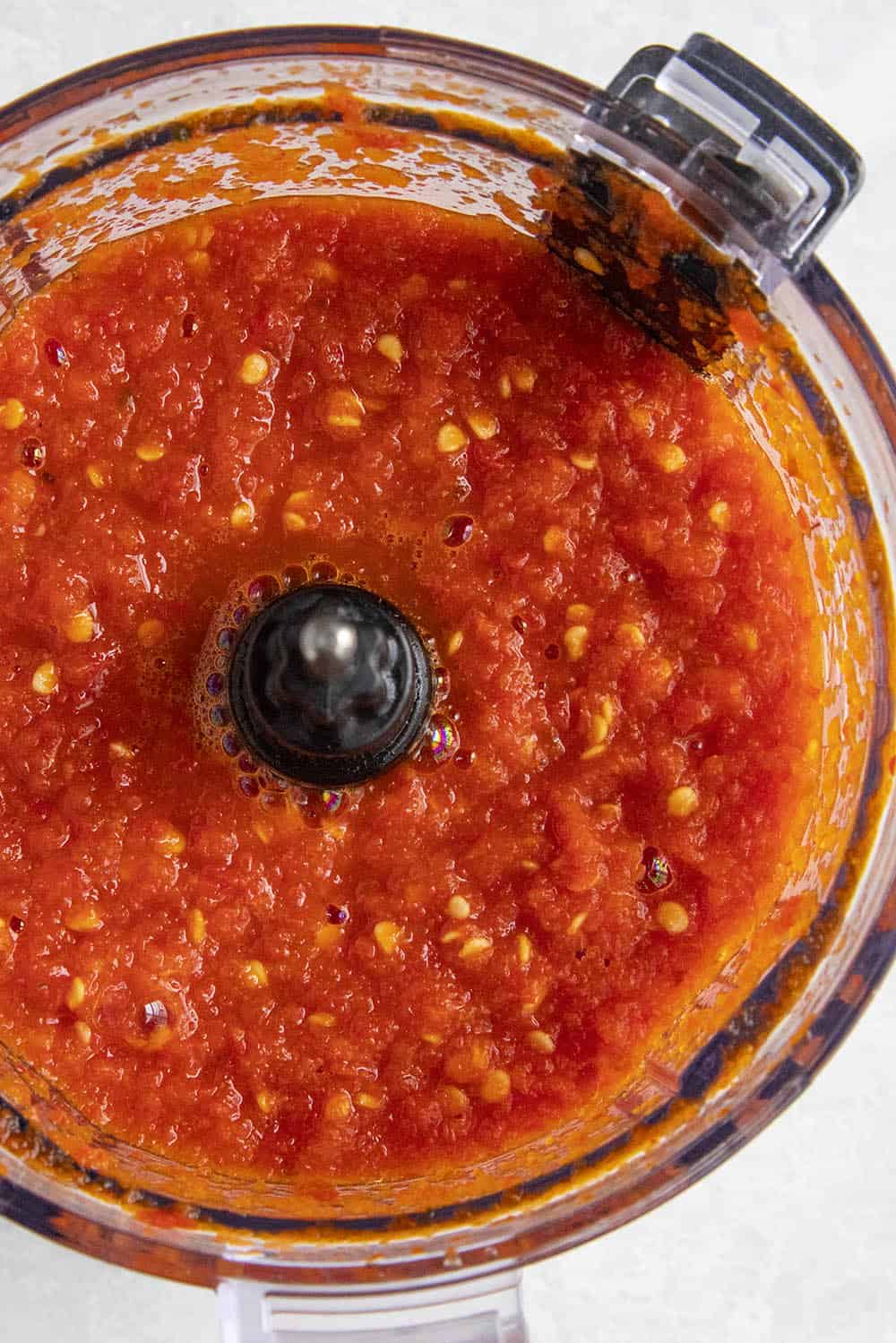
OPTIONAL: Add the fermented hot sauce to a pot and bring to a quick boil. Reduce heat and simmer for 15 minutes. This will stop the fermentation process.
NOTE: You don't have to cook the sauce if you don't want to. Cooking removed the probiotic benefits. It can be used as-is, though you will likely see some continued fermenting activity. If you decide to not cook it, store it in the refrigerator in sealed containers.
You may need to burp them to release gas buildup every now and then, though refrigeration will slow the activity.
Strain the mixture to remove the solids if desired, or use as-is for a thicker hot sauce. Pour into hot sauce bottles and enjoy.
That's it, my friends! Easy, right? Who knew making a fermented hot sauce could be so simple? It's really quite a bit like famous Tabasco Hot Sauce, though made with red serrano peppers instead of tabasco peppers.
Recipe Tips & Notes
Fermentation Time. Feel free to ferment longer if you'd like. Continuing to ferment the peppers will develop even more flavor. I have fermented peppers for 6 months in the past.
Some people ferment for years. 1 week, however, is enough to get a good ferment.
Kahm Yeast. Sometimes you may notice a white film forming on the top of your ferment. It is sour and can form when all of the sugar in your ferment is consumed.
It is not a mold, nor is it harmful. It can affect the flavor of your finished hot sauce, so it is best to be scraped away from your ferment.
Thicker or Thinner Hot Sauce. If you're looking for a thicker hot sauce, only use a combined half cup of brine and vinegar, and do not strain the hot sauce.
For a thinner hot sauce, add more water and/or vinegar a bit at a time until you achieve the consistency you want.
Straining the hot sauce will thin it out considerably.
Other Ingredients. This is a very simple Louisiana Style Hot Sauce recipe, using only peppers, vinegar and salt.
You can easily include other ingredients to build flavor, such as garlic, onion, herbs and other seasonings.
Other Peppers. This method works with any type of chili peppers. Try it with a blend of hot peppers and/or mild peppers.
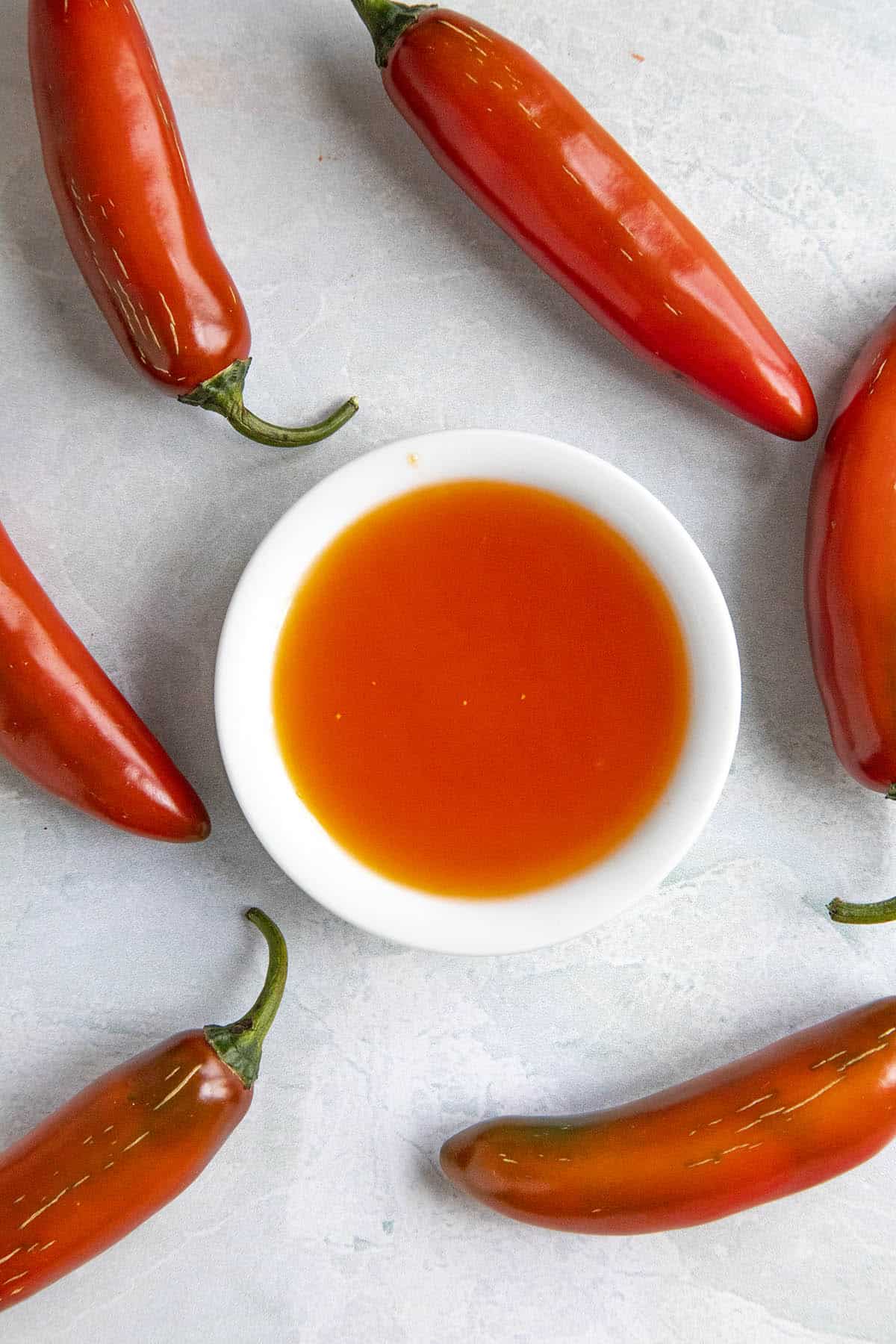
Frequently Asked Hot Sauce Questions
Here are answers to some of the most common questions I get on other hot sauces.
How long will this sauce keep?
Fermented hot sauce will keep for many months in the refrigerator, or even longer. It's all about the acidity.
To be technical, target level ph for shelf stable foods is below 4.6 ph, but should probably be lower for home cooks, around 3.5 or so, to account for errors.
If you're concerned, add more vinegar to lower the ph. I measured the pH of my finished fermented hot sauce at 3.7, but check with a good pH meter.
The best ph meters that I recommend are from Thermoworks. Get yourself a ph meter from Thermoworks today. I am a happy affiliate.
Fermented hot sauces that are not cooked at the end with vinegar and/or citrus should be refrigerated.
Cooking them stops the fermentation activity and makes them more shelf stable, though they are no longer probiotic.
Where'd you get that sauce bottle?
I find them locally sometimes, but I also order through Amazon. Here is a link to some bottles I like (affiliate link, my friends!): Swing Top Glass Bottles, 8.5 Ounce - Set of 4.
If you like the smaller bottles that most hot sauce makers use, here's another link: Hot Sauce Bottles, 5 Oz - 24 Pack.
Can I process this hot sauce for longer storage?
Absolutely. Just be sure to use proper canning/jarring safety procedures. Processing the hot sauce in a water bath stops the bacterial activity, making the hot sauce shelf-stable.
However, it will no longer be probiotic. The National Center for Home Food Preservation provides home canning instructions and many recipes that have been tested for food safety. NCHFP.uga.edu.
Useful Equipment
Aside from jars and your ingredients, I like to use Masontops lids, which include pickling weights and a membrane allowing gases to escape without the need for burping.
You can use them with any wide mouth mason jar. Here is a link to where you can buy them on Amazon. It’s an affiliate link, my friends. FYI!
Buy Masontop Lids for Fermenting Chili Peppers (and More)
I also highly recommend this outstanding book by fermenting experts, Kirsten K. Shockey and Christopher Shockey – “Fiery Ferments: 70 Stimulating Recipes for Hot Sauces, Spicy Chutneys, Kimchis with Kick and Other Blazing Fermented Condiments”. I learned a lot from this book as well as through my own experimentation. Grab a copy today.
Good luck, and happy fermenting! Let me know what you make with your pepper mash.
Try Some of My Other Fermented Hot Sauce Recipes
Here are some of my own recipes that use fermented chili peppers.
- Homemade Sriracha Hot Sauce
- Fermented Aji-Garlic Hot Sauce
- Homemade Louisiana Hot Sauce
- Homemade Tabasco Sauce
- Spicy Serrano Hot Sauce
Check out more Hot Sauce Recipes or learn more about How to Make Hot Sauce.
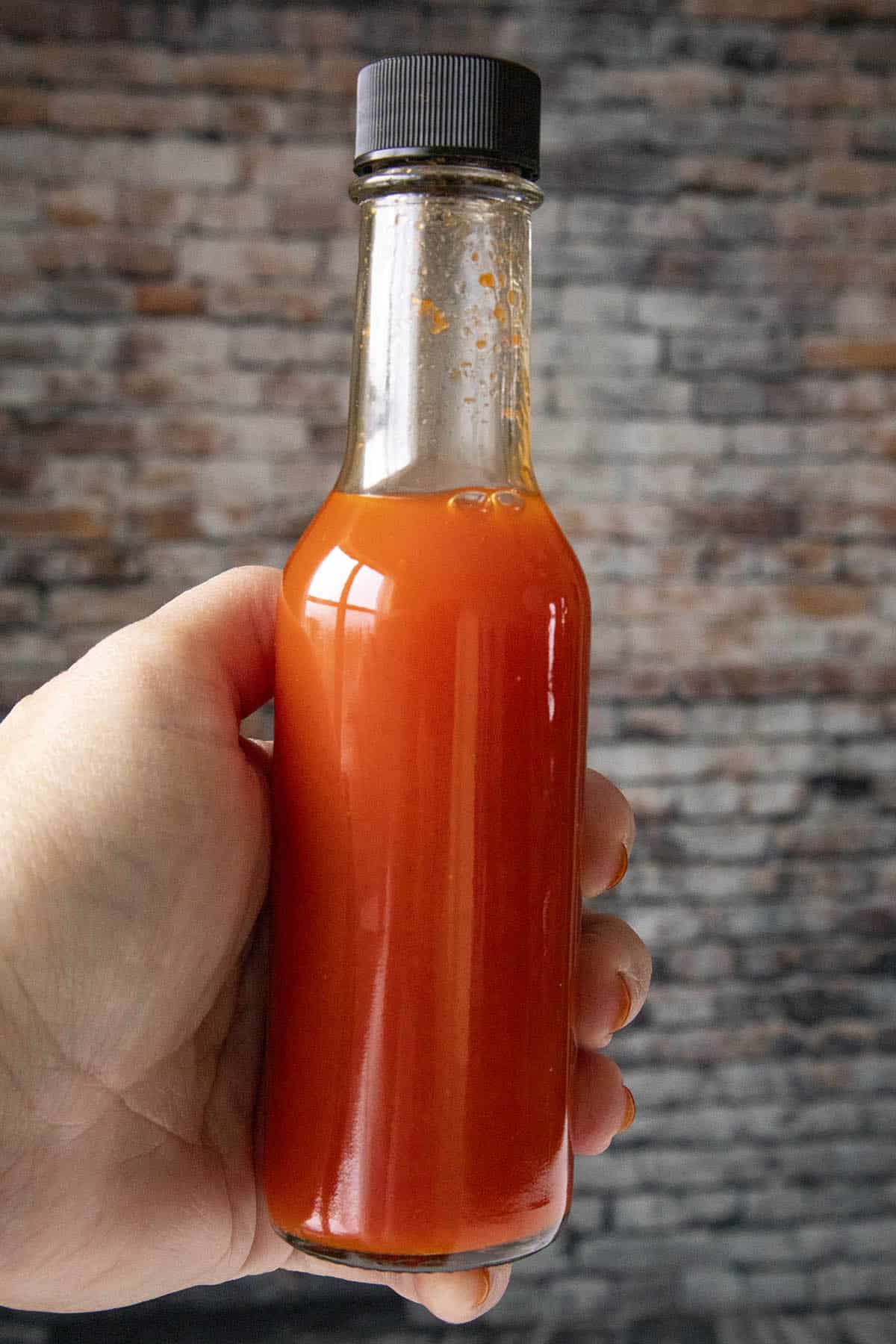
Got any questions? Ask away! I’m happy to help. If you enjoy this recipe, I hope you’ll leave a comment with some STARS. Also, please share it on social media. Don’t forget to tag us at #ChiliPepperMadness. I’ll be sure to share! Thanks! — Mike H.
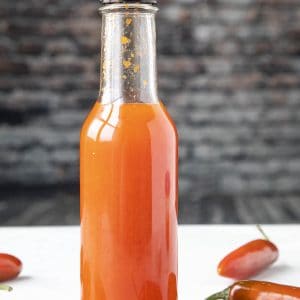
Fermented Hot Sauce Recipe
Ingredients
- 1 pound red serrano peppers or use any chili peppers, stems removed
- 1 quart unchlorinated water
- 3 tablespoons sea salt (do not use iodized salt)
- ½-1 cup white wine vinegar to your preference use a good quality vinegar for better quality hot sauce
Instructions
- First, ferment the serrano peppers. Roughly chop the peppers, then pack them into a ball jar, leaving at least 1 inch of head space. The peppers may rise a bit when fermenting.
- Next, mix 1 quart unchlorinated water with 3 tablespoons sea salt. Pour just enough brine over the peppers to cover them, pressing them down a bit as you go. It is important to keep the peppers covered with brine to avoid spoilage. Check this daily.
- Screw on the lid and set the jar away from direct sunlight to ferment for at least 1 week. Ideal temperatures are between 55-75 degrees F. The most active fermentation period is between 1-2 weeks, so be sure to monitor it during this time. “Burp” the jars often by unscrewing the lid a bit to let out some of the accumulating gases. Or, use an airlock or membrane for easier fermenting. See our page, “How to Ferment Peppers”, for more detailed instruction.
- After 1-2 weeks, the fermenting activity will diminish and the brine will turn cloudy and taste acidic.
- Drain the peppers, but reserve the brine.
- Add the fermented peppers to a food processor or blender, along with 1/2 cup of the brine and 1/2 cup vinegar. You can add more or less of each as desired to your preference. More brine will have more salty flavor, more vinegar will be more acidic.
- Process until smooth.
- Optional Step. Add the fermented hot sauce to a pot and bring to a quick boil. Reduce heat and simmer for 15 minutes. This will stop the fermentation process and meld the flavors, but will remove the probiotic benefits.
- Strain the mixture to remove the solids if desired, or use as-is for a thicker hot sauce. Pour into hot sauce bottles and enjoy.
- You can add more vinegar or water to thin out the hot sauce.
Notes
Nutrition Information




Andrew says
just did mine after 4weeks of fermenting the aroma is already amazing
Mike H. says
Awesome - thank you, Andrew!
Helen says
I'm just about to make my serrano sauce. It's fermented for a week and it's been warm here so she's ready.
I'm in Australia and we don't have chipotle in cans here so I made my own. I'm having trouble finding recipes for chipotles without needing the adobo sauce.
I'm pretty proud of myself growing, smoking and finally making the sauce.
You have inspired me Mike.
Mike H. says
I am happy I have been an inspiration for you, Helen. Keep rocking!
Jason says
Is it not true that vinegar prevents healthy bacteria from producing during the “Fermentation” process?
Mike Hultquist says
It can indeed from my understanding, but in higher concentrations. Smaller amount can actually speed up some ferments. I use it for flavor and get my probiotic benefits elsewhere.
Tony says
I eat a LOT of hot sauce, so when I make it, I normally make it in fairly large batches of a finished gallon or more. This takes a lot of peppers, which I grow myself. I have limited space, so it takes multiple harvest to get enough peppers. I currently either freeze them (danger of frost bite) or dehydrate them to preserve them long enough to save up enough. After reading some of the comments here, dehydrating might be the best option. Once rehydrated, will adding other veggies, such as onions, work to kick off the fermentation?
Mike Hultquist says
Tony, yes, the added fresh veggies should help fermentation get going, even a few fresh peppers can work. Enjoy!!
Rick says
Love this recipe. I've made 3 batches so. Tai peppers, Tai dragon peppers, and Trinidad Moruga Scorpions. Fantastic results. Second batch of Scorpion peppers now fermented and ready to finish. All home grown in my backyard. I'm 66 and somewhat of a hot sauce/ hot pepper connoisseur. Love these sauces on tacos / Mexican food, omelets, brats and mettwurst
Mike Hultquist says
Boom!! I love to hear it, Rick! Thank you for sharing this. Enjoy!
David Bardin says
I made fermented ghost peppers into a puree and it’s way too hot. Do you have a recipe to mix fermented peppers with to make a more tolerable hot sauce for everyday use? I made both ghost and cayenne purées and canned them. Thank you
Mike Hultquist says
Hey, David. Ouch, I hear you. Best way is dilution, really. You can use just a little bit of it in different dishes, or make another batch with low or not heat peppers (bells), then mix them together. You can look at my Hot Sauce Recipes (https://www.chilipeppermadness.com/chili-pepper-recipes/hot-sauces/) and mix maybe 1 teaspoon or so into an of them for heat. Let me know if this helps. Happy to help more.
Travis OWEN says
I use 11 oz of red habaneros and 11 oz. of red jalapeno and one red bell pepper. works perfect. those weights are before the stem is removed
Poppy says
I want to make a fermented hot sauce with green serrano chiles and I have a couple of questions.
Can I do a ferment with mostly DRIED chiles de arbol (for color) with a few FRESH serranos (for heat)? In other words, putting the dried chiles in the brine with the fresh chiles.
Or, should I use dried chiles de arbol with a few fresh habaneros added for heat?
A primary goal is having a lovely red hot sauce.
Also, does heating the sauce kill off any probiotic benefits and can I skip that step?
Thanks in advance!
Mike Hultquist says
Poppy, you can ferment dried chilies, but it might need a starter. You can toss in some fresh pods to help get fermentation started, fresh serranos or fresh habaneros for more heat. Yes, cooking the final ferment does stop the probiotic benefits. You can skip that step. Enjoy!!
Poppy says
Thanks for the reply! I'm starting a couple of different pints today. And I'll try to read a little more closely in the future. I skipped over the bold face bit that says "NOTE: You don't have to cook the sauce if you don't want to. Cooking removed the probiotic benefits."
Thanks again!
I enjoy the site.
Poppy
Mike H. says
Very welcome! =)
Poppy says
Wow! Massive success here with fermenting dried chiles. The dried arbol with fresh serrano I made is going to be perfect for tacos and quesadillas. And the dried arbol with fresh habanero is just an all around winner...tacos, quesadillas, omelettes. I might even dab a little on my wrists and wear it as cologne. I also made a fresh serrano ferment which should go well with shrimp tacos. Next up...a dried chipolte with fresh habanero ferment.
Mike Hultquist says
Very nice! I love to hear it, Poppy! Awesome! Glad to help.
Poppy says
The dried chipotle with fresh habanero ferment (with a decent amount of garlic cloves) is another home run. After blending, straining and bottling, I whipped up some scrambled eggs. Perfection.
I will definitely try variations on this one...maybe shredded carrot or a couple of pieces of mango or some blueberries...ingredients with a little more sugar for a more active ferment.
But really, peppers, brine, garlic and patience seems to get the job done very, very well. I think I'm all in on fermented hot sauce going forward.
Mike H. says
Excellent. Happy to hear it, Poppy. Enjoy!
Tracey says
My hot sauce separated after being stored in the fridge. Is this normal?
Mike Hultquist says
Tracey, yes, this is very normal. Give it a good shake and it will come back together. Some people use stabilizers with hot sauces, like xanthan gum, but you really don't need it. Thinner sauces tend to separate a bit. But just shake them. I hope this helps.
Cherie says
I am eagerly anticipating another batch of fermented Sugar Rush Peach and scorpion peppers. I have had excellent outcomes using your recipes for the last few years and am venturing into adding some additional ingredients.
You mentioned that the quality/variety of white wine vinegar is important. Do you have a favorite from your experience?
Also, I have bottles that can use a heat seal foil cover over a plastic screw top. It appears there is a small hole in the top of the foil, but if I do not cook down, would you recommend not using the foil in case it continues to ferment in the fridge? How would I tell if it needs to be burped?
Love your site and the cookbooks! Definitely recommend the hard copy. Sometimes you don't know what you're looking for until find it 🙂
Mike Hultquist says
Thanks, Cherie. I don't have a favorite brand or anything, but I like to find a good quality small batch white wine vinegar, rather than the huge jugs that I use for pickling. Though, those still work, too. As long as you like the taste. For the burping, it's hard to say. Refrigeration really slows any continuing fermentation, but I've heard so many stories of bottles exploding. I appreciate it! Thanks for the support!!
Justin says
hey man love your site/recipes, I've made several over the years and they are always good
if I wanted to smoke the peppers, if you've tried it, would you do it pre or post fermentation and why?
Mike H. says
Hey, Justin. It's generally best to smoke the peppers before fermentation - for the better flavor integration and also texture. Smoking softens and partially dries out the peppers, which is perfect for fermenting. Smoking them after could dry the peppers out too much.
melly says
Excellent sauce recipe. Thank you for sharing.
Mike Hultquist says
Thanks, Melly!
ali says
nice work.